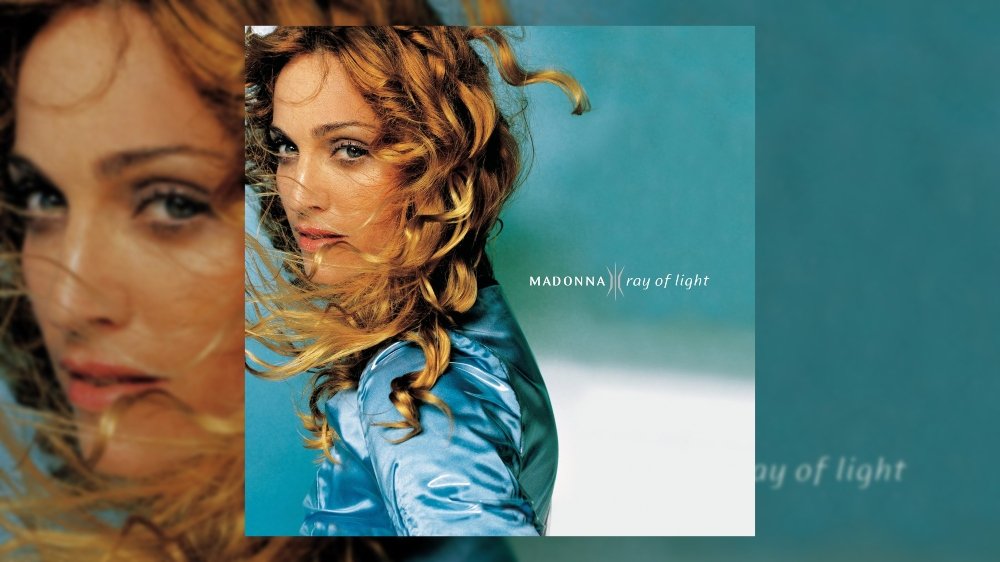Happy 25th Anniversary to Madonna’s seventh studio album Ray of Light, originally released in Japan February 22, 1998, in the UK March 2, 1998 and in the US March 3, 1998.
With a slick Mario Testino cover photo, and a serene stare over the shoulder of an impeccable ice blue Dolce & Gabbana raincoat, Madonna’s 1998 album Ray of Light ushered in a more mature era for the Queen of Pop. One of the best-selling records of all time, Ray of Light is Madonna’s most critically acclaimed album, and arguably the most transformative moment for an artist in a constant cycle of reinvention. While using “personal” to describe an album is almost a cliché, the themes of motherhood and spirituality give a depth and intimacy that hadn’t fully developed in Madonna’s nearly 20-year music career.
Ray of Light took four months to record, the longest Madonna had spent in the studio working on one album. Beginning the production with Babyface, then Patrick Leonard, Madonna abandoned earlier material and sought the help of a relatively unknown British producer known as William Orbit. Her manager Guy Oseary introduced her to the producer and songwriter who had previously recorded remixes of a handful of her tracks. This collaboration introduced a new style, one that felt fresh and of the time, a transformation to further extend the singer’s already prolific career.
In retrospect, Ray of Light can feel like an attempt to incorporate several styles popular in the mid 90’s—a smattering of trip hop, ambient, drum and bass, for an overall “electronica” effect. New Age production style and lyrics, due in part to Madonna’s newfound spirituality and connection to the mystical Jewish faction, Kabbalah, as well as a fervent devotion to yoga, bring a completely different flavor to the singer’s catalog.
The Middle Eastern influences (and a dash of Hinduism and Buddhism for good measure) run throughout the album right alongside the throbbing electronic heart. This fusion of styles would work its way into the pop culture of the aughts, influencing more traditional singers like Nelly Furtado and Adele, and setting the proverbial stage for indie acts like Fatboy Slim.
Ray of Light would launch four wildly popular singles, the first of which was “Frozen.” With a lush dramatic opening, perhaps some leftover theatricality from her stint as Evita, “Frozen” became an unlikely hit. The mid-tempo ballad, full of strings and cryptic lyrics, was ubiquitous on the Top 40 charts in 1998. Years later, in 2022, Canadian producer Sickick released a remix of the track, which was then shared millions of times via a popular TikTok trend, proving the long-lasting appeal of “Frozen.”
Listen/Watch (Playlist):
The title track “Ray of Light” is a standout banger of a club track. Released as the second single off the album and accompanied by a dizzying, epic music video, “Ray of Light” stands the test of time, firmly earning its spot in the Madonna canon. The joyful, oscillating synths take the listener on a ride through Madonna’s anthem of self-discovery and freedom, a bright spot amongst the moodier material of the album.
Alongside the two huge, standout singles, Ray of Light gives us several distinctive, personal tracks. “Nothing Really Matters,” a classic house beat that harkens back to Madonna from a decade earlier. “Candy Perfume Girl” is a good example of Madonna taking a style and making it fit her own musical catalog, an obvious nod to the trip hop trend, but made into a classic Madonna pop song.
The haunting rave banger “Sky Fits Heaven,” a break-speed trance track, proves she can still get the club going when the beat drops. The only skip on the album is “Shanti / Ashtangi.” While a lovely declaration of Madonna’s passionate relationship to yoga, it feels slightly problematic. A white woman chanting in Sanskrit probably wouldn’t happen in 2023—it would require a cultural step in a less cringe direction.
Much like her bringing Chicago house to the mainstream in the early 90’s, Ray of Light brought electronic music to the forefront of pop culture, opening the door to prominence for the mostly underground dance scene. It signaled a new turn for Madonna, a more grown-up stage of her career. And while Ray of Light is full of surprising and inventive moments, Madonna remained true to her pop star roots, creating a multimedia experience for an international fanbase to enjoy.
Much more than just a late career dance project, Ray of Light introduced the world to a new Madonna, one not seen in the 20 years prior, but still beloved and relevant 25 years later—something only Madonna could pull off.
LISTEN:

